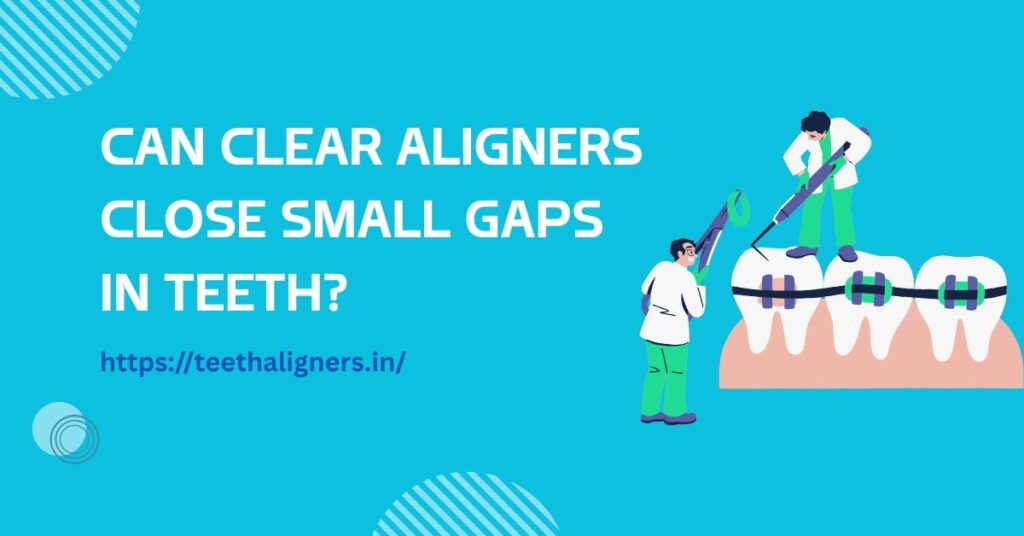Have you ever looked in the mirror and noticed a small gap between your teeth that made you feel less confident about your smile?
Many people struggle with this issue, and while the gap may seem minor, it can feel significant when you smile, talk, or take pictures.
Small gaps in teeth are very common, but they can cause discomfort both emotionally and physically. For some, it leads to embarrassment, while for others, it creates functional problems such as trapping food or causing slight speech issues.
Modern dentistry now offers simple and effective solutions to close these gaps without relying on bulky braces. One of the most popular advancements is the use of clear, removable trays that gradually bring the teeth closer together.
These Clear Aligners have changed how people approach orthodontic treatment, especially those who want a solution that is less noticeable and more convenient.
Table of Contents
ToggleWhat Causes Small Gaps Between Teeth?
Small gaps, often called diastemas, appear for a variety of reasons. For many people, genetics play a large role. If your teeth are naturally smaller than the size of your jaw, spaces can form between them.
This uneven proportion leaves visible gaps, especially in the front teeth. Childhood habits are another common cause. Thumb sucking, prolonged pacifier use, or tongue thrusting can push teeth apart over time.
These behaviors apply constant pressure on the front teeth, eventually leading to spacing. Modern solutions like Clear smile aligners are often recommended by dentists to close such gaps in a discreet and gradual way.
Missing teeth can also create extra room in the mouth. When a tooth is lost or doesn’t grow in properly, nearby teeth drift into the empty space, creating visible gaps.
Similarly, if the jaw grows unevenly, teeth may not sit closely together, leaving spaces behind. Regardless of the cause, many people feel that these gaps make their smile look incomplete.
Why Do People Want to Fix Small Gaps?
For many, the main reason is appearance. A small gap in the front teeth can stand out in photographs and everyday interactions. This can reduce self-confidence, making people hesitant to smile openly or speak freely.
However, the concern isn’t always cosmetic. Small gaps can trap food particles, which makes cleaning more difficult. Over time, this increases the risk of plaque buildup, gum irritation, or even cavities.
Some people also notice changes in their speech, such as a mild lisp, when gaps are present in the front teeth.Closing gaps, therefore, is not just about creating a better-looking smile. It also supports oral health and everyday comfort.
How Do Clear Aligners Work?
Clear Aligners are removable trays made from durable, safe plastic that fit snugly over your teeth. They are created using digital scans of your mouth, which allow dentists to design a series of trays that gradually move the teeth closer together.
Each set of trays is slightly different, applying gentle, steady pressure to shift teeth toward the desired position.Patients usually wear each set for about two weeks before switching to the next one.
Over time, these small movements add up, and the teeth shift until the gap is closed.Unlike traditional braces, aligners do not use wires or brackets.
They are nearly invisible, which makes them an attractive choice for teenagers and adults who want to fix gaps without drawing attention to the treatment.
Another key advantage is that they can be removed while eating, brushing, and flossing, making daily hygiene easier and more comfortable.
Can Clear Aligners Fix Small Gaps in Teeth?
The answer is yes. Aligners are especially effective for closing mild to moderate gaps. Because the trays apply gentle, consistent pressure, they gradually bring the teeth closer together until the gap disappears.
Dentists often recommend aligners for gap closure because they are discreet and more comfortable than braces. They also work well in cases where gaps are the main concern rather than severe bite issues.
However, aligners do have some limitations. Very wide gaps or cases that involve missing teeth may need additional treatments like bonding, veneers, or implants. Still, for many patients with small gaps, aligners provide an effective and reliable solution.
Examples of Successful Gap Closure with Aligners
A common example involves patients who have a slight gap between their two front teeth. With consistent use of aligners, the teeth gradually move closer together until the space is closed.
In places like Delhi, aligners are becoming more popular among young professionals and students who want to improve their smiles without wearing visible braces.
These patients often report higher confidence during treatment since the trays are nearly invisible and easy to manage in social settings.
What Are the Benefits of Using Clear Aligners for Small Gaps?
Choosing aligners to close small gaps offers several advantages. First, they are comfortable. Unlike braces, which can cause soreness from wires or brackets, aligners are smooth and fit snugly against the teeth.
Second, they are removable. Patients can take them out during meals, which means no food restrictions. This feature also makes brushing and flossing easier compared to braces, reducing the chances of cavities or gum disease during treatment.
Another important benefit is their appearance. Because the trays are transparent, most people won’t even notice them. This makes aligners particularly appealing to adults who want a professional look while undergoing treatment.
Lastly, the convenience of aligners often encourages people to stick with treatment. When patients feel comfortable and confident, they are more likely to wear the trays consistently, which leads to successful results.
Are There Any Limitations?
Aligners work best for mild spacing issues, but they may not be suitable for every case. If the gap is too wide, additional dental procedures may be necessary. Similarly, if spacing comes with more complicated bite problems, braces or a combination of treatments might be recommended.
Patient discipline is also critical. Aligners need to be worn for 20 to 22 hours a day. If a patient forgets to wear them consistently, the treatment may take longer or may not deliver the desired outcome. Regular visits to the dentist are important to make sure the teeth are moving according to plan.

How Long Does It Take to Close Small Gaps?
The length of treatment depends on several factors. On average, small gaps can be closed within four to nine months. In some cases, it may be shorter, especially if only one small gap is being corrected.
The speed of results depends on the size of the gap, the age of the patient, and how well they follow instructions. Younger patients often respond faster because their teeth and bones are more adaptable.
However, adults can also achieve excellent results with consistent use.Wearing the trays as directed, attending check-ups, and maintaining good oral hygiene all contribute to quicker, more effective treatment.
Cost of Closing Small Gaps with Aligners in Delhi
The cost of aligner treatment varies depending on the number of trays required and the complexity of the case. Generally, closing small gaps costs less than correcting more complex orthodontic issues.
In Delhi, the demand for aligners has grown significantly in recent years. More clinics now offer treatment, making it easier for patients to find affordable options.
While prices vary between clinics, most patients agree that the investment is worthwhile given the convenience, comfort, and improved smile that aligners provide.
What to Expect During Treatment
The process begins with a consultation where the dentist examines your teeth and discusses your goals. Digital scans are then taken to create a 3D model of your mouth. This model helps design a custom treatment plan and shows how your teeth will move over time.
After the plan is approved, you receive a set of trays. Each tray is worn for about two weeks before switching to the next one. Regular check-ups with the dentist help ensure the teeth are moving correctly.
At first, wearing the trays may feel slightly uncomfortable, but this usually fades within a few days. As treatment continues, most patients adjust easily and find the process simple to follow.
How to Maintain Results After Treatment
Closing the gap is only part of the journey. After treatment, it’s important to keep the teeth in their new positions. Dentists usually recommend wearing retainers at night to prevent teeth from shifting back.
Daily oral care is just as important. Brushing twice a day, flossing regularly, and visiting the dentist for routine cleanings help maintain healthy gums and stable teeth. Skipping these steps could allow gaps to reappear.
Patients who stay consistent with retainers and oral hygiene enjoy long-lasting results and a confident smile.
Conclusion
Small gaps between teeth may seem like a minor issue, but they can have a big impact on confidence and oral health.
Modern orthodontics now makes it possible to close these gaps with clear, comfortable, and nearly invisible treatments. For many patients, aligners provide an effective way to achieve a balanced and confident smile.
If you are considering this option, consulting a trusted provider such as Teeth Aligners in India can help you understand the best approach for your needs and guide you through the process with expert care.

